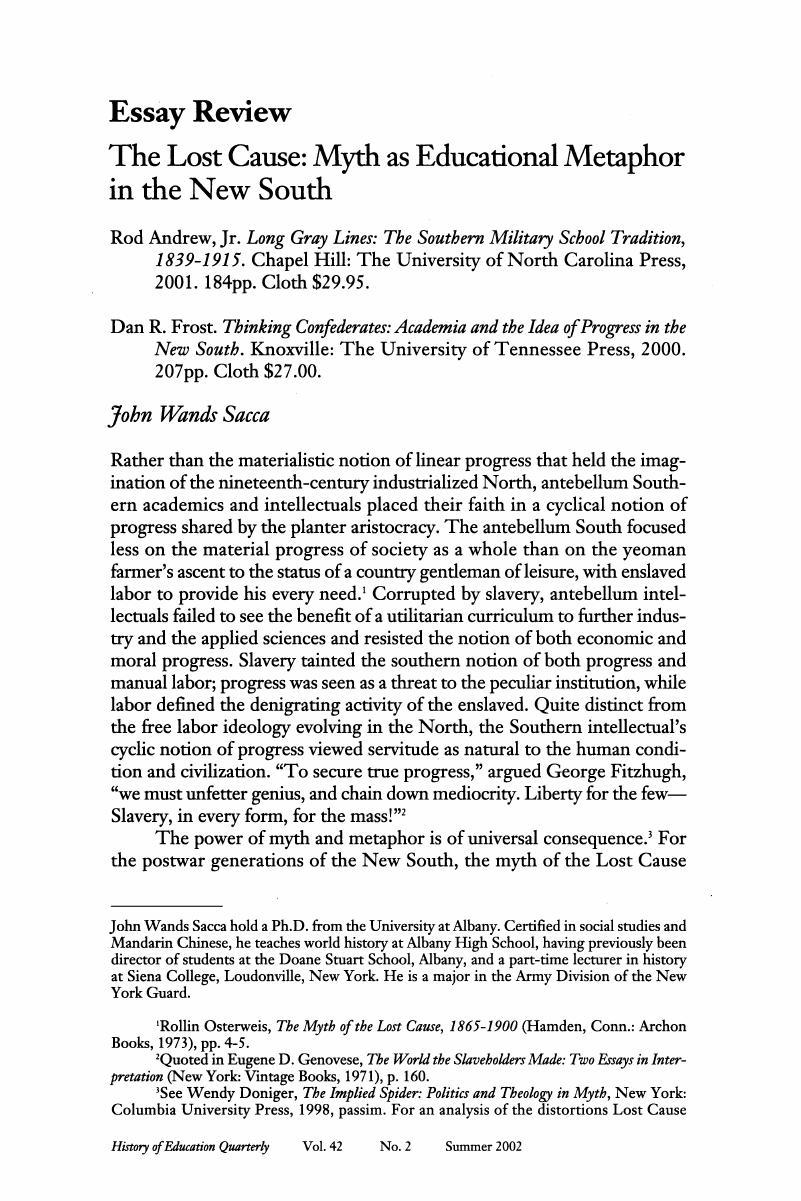No CrossRef data available.
Published online by Cambridge University Press: 24 February 2017

1 Osterweis, Rollin The Myth of the Lost Cause, 1865–1900 (Hamden, Conn.: Archon Books, 1973), pp. 4–5.Google Scholar
2 Quoted in Genovese, Eugene D. The World the Slaveholders Made: Two Essays in Interpretation (New York: Vintage Books, 1971), p. 160.Google Scholar
3 See Doniger, Wendy The Implied Spider: Politics and Theology in Myth, New York: Columbia University Press, 1998, passim. For an analysis of the distortions Lost Cause mythology has promoted, see Gary W. Gallagher and Alan T. Nolan, eds., The Myth of the Lost Cause and Civil War and Civil War History, (Bloomington: Indiana University Press, 2000), passim.Google Scholar
4 Osterweis, The Myth of the Lost Cause, p. ix.Google Scholar
5 Ben-David, Joseph Centers of Learning: Britain, France, Germany, United States (New York: McGraw-Hill Book Co., 1977), p. 60.Google Scholar
6 As the careers of these academics predate the Progressive era, Frost uses the term “progressivist.”Google Scholar
7 Virginia residents attending the Virginia Military Institute (VMI) were expected to spend a period of time recompensing the state for their education by teaching in a school district within the state, joining the state's National Guard, or serving as engineers on state highways. VMI application, VMI Archives, Lexington, Virginia.Google Scholar
8 Reeves, Ira L. Military Education in the United States (Burlington, Vt.: Free Press Printing Co., 1914), pp. 188–189. Neither author cites this unique and reliable source of information on American military education.Google Scholar
9 Emphasis in the original.Google Scholar
10 Andrew, Rod Jr. “Soldiers, Christians, and Patriots: The Lost Cause and Southern Military Schools, 1865–1915,“ Journal of Southern History 64, no. 4 (November 1998): 677–710.CrossRefGoogle Scholar
11 Moody, Joseph N. French Education Since Napoleon (Syracuse: Syracuse University Press, 1978), p. 80.Google Scholar
12 Neiberg, Michael S. Making Citizen-Soldiers: ROTC and the Ideology of American Military Service (Cambridge: Harvard University Press, 2000), p. 21.Google Scholar
13 Reeves, Military Education in the United States, pp. 113–154.Google Scholar
14 Riotous behavior was not restricted to the South. The Christmas Eve “eggnog riot” of 1825 was a notorious example of mutiny at the United States Military Academy, West Point. Cadet Jefferson Davis of Mississippi narrowly escaped expulsion. Nineteen cadets would be convicted and separated for misconduct. For a first-hand account of the riot, see James Miller to C.G. Atherton, Esquire, 21 January 1826, Special Collections, United States Military Academy Library.Google Scholar
15 See Tables I and II in Reeves, Military Education in the United States, pp. 108–111.Google Scholar
16 For insight into the frustrations faced by two privates in the 9th and 10th Cavalry regiments, respectively, see David C. Glasgow to Secretary of War, 6 August 1885, National Archives, Record Group 94, 5746 Appointment, Commission and Promotion File, 1885; and Albert, N. Rodgers to Samuel Randall, J. 29 March 1887, National Archives, Record Group 94, 1735 Appointment, Commission and Promotion File, 1887.Google Scholar
17 Reeves, Military Education in the United States, pp. 107–111.Google Scholar